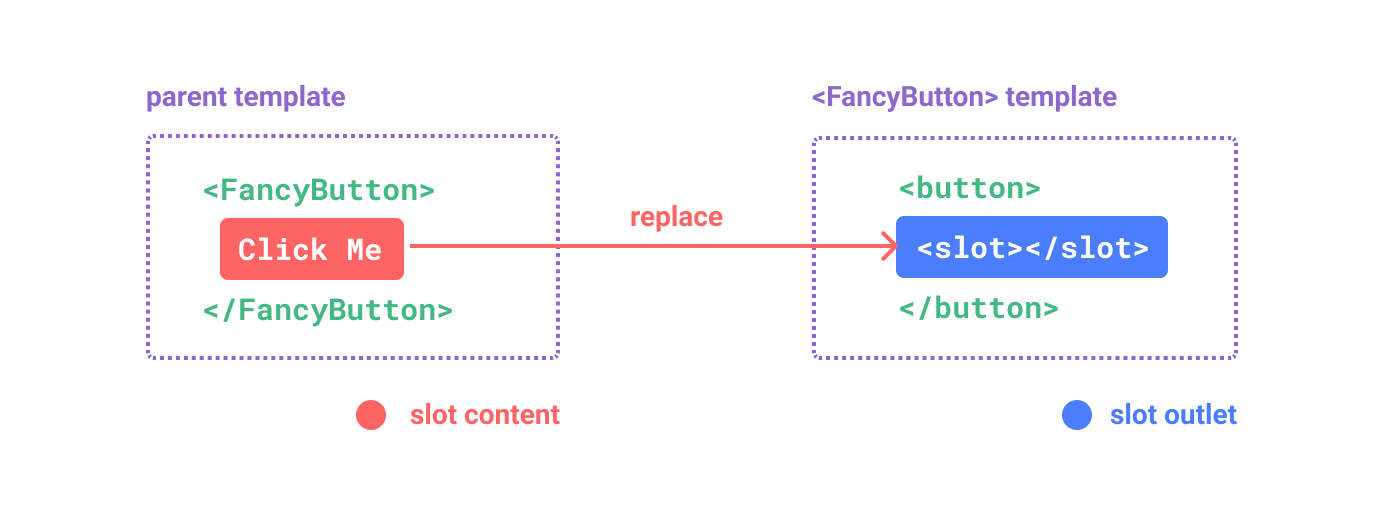Vue3基础——插槽Slots
开始
使用插槽可以实现动态的模板内容
父模板中的插槽内容可以访问到父组件的数据作用域,但不能访问到子组件的数据作用域
默认插槽
不具有name属性的插槽为默认插槽
父组件基本使用
1
2
3
4
5
6
7
8
9
10
11
12
13
14
<script setup lang="ts">
import {ref} from 'vue';
import Inner from "@/components/Inner.vue";
let value1 = ref('value1');
</script>
<template>
<div>
<Inner>
<!--该部分内容会填充到插槽中-->
<span>{{value1}}</span>
</Inner>
</div>
</template>
子组件基本使用
1
2
3
4
5
6
7
8
9
<script setup lang="ts">
</script>
<template>
<div>
<!--slot标签定义默认插槽-->
<slot></slot>
</div>
</template>
slot标签中的模板内容为默认填充内容,当父组件未定义插槽内容时,使用默认内容填充
1
2
3
4
5
6
7
8
9
<!--子组件-->
<template>
<div>
<slot>默认内容</slot>
</div>
</template>
<!--父组件-->
<Inner></Inner>
具名插槽
可以为slot设置名称,指明插槽内容填充的slot
- slot标签使用name属性设置名称
- 使用
v-slot指令指明填充的slot,该指令可用于组件标签或template标签上,可简写为#
当同时使用具名插槽和默认插槽时,可使用显式默认插槽或隐式默认插槽
- 显式默认插槽:使用
v-slot:default指明填充到默认插槽- 隐式默认插槽:组件标签中所有的直接非template标签将作为默认插槽内容
基本使用
1
2
3
4
5
6
7
8
9
10
11
12
13
14
15
16
17
18
19
20
21
<!--子组件-->
<template>
<div>
<slot name="header"></slot>
<slot name="content"></slot>
</div>
</template>
<!--父组件-->
<template>
<div>
<Inner>
<template v-slot:header>
<span>这是header</span>
</template>
<template #content>
<div>这是content</div>
</template>
</Inner>
</div>
</template>
作用域插槽
使用作用域插槽可向插槽内容提供子组件的数据
- 在子组件的slot标签中传递参数
- 在父组件中接收参数
基本使用
1
2
3
4
5
6
7
8
9
10
11
12
13
14
15
16
17
18
<!--子组件-->
<div>
<!--通过v-bind传递参数-->
<slot :text="greetingMessage" :count="1"></slot>
</div>
<!--父组件-->
<!--使用一个对象接收参数-->
<MyComponent v-slot="slotProps">
{{ slotProps.text }} {{ slotProps.count }}
</MyComponent>
<!--
接收参数时可以使用解构
<MyComponent v-slot="{ text, count }">
{{ text }} {{ count }}
</MyComponent>
-->
在同时使用默认插槽和具名插槽时,作用域插槽必须显式指明默认插槽
1
2
3
4
5
6
7
8
9
10
11
12
<template>
<MyComponent>
<!-- 使用显式的默认插槽 -->
<template #default="{ message }">
<p>{{ message }}</p>
</template>
<template #footer>
<p>Here's some contact info</p>
</template>
</MyComponent>
</template>
其他特性
条件插槽
$slots对象用于获取父组件传入所有插槽填充内容,配合v-if可实现条件渲染slot标签
1
2
3
4
5
6
7
8
9
10
11
12
13
14
15
<template>
<div class="card">
<div v-if="$slots.header" class="card-header">
<slot name="header" />
</div>
<div v-if="$slots.default" class="card-content">
<slot />
</div>
<div v-if="$slots.footer" class="card-footer">
<slot name="footer" />
</div>
</div>
</template>
动态插槽名
在v-slot指令上可使用动态插槽名
1
2
3
4
5
6
7
8
9
10
<base-layout>
<template v-slot:[dynamicSlotName]>
...
</template>
<!-- 缩写为 -->
<template #[dynamicSlotName]>
...
</template>
</base-layout>
本文由作者按照 CC BY 4.0 进行授权

